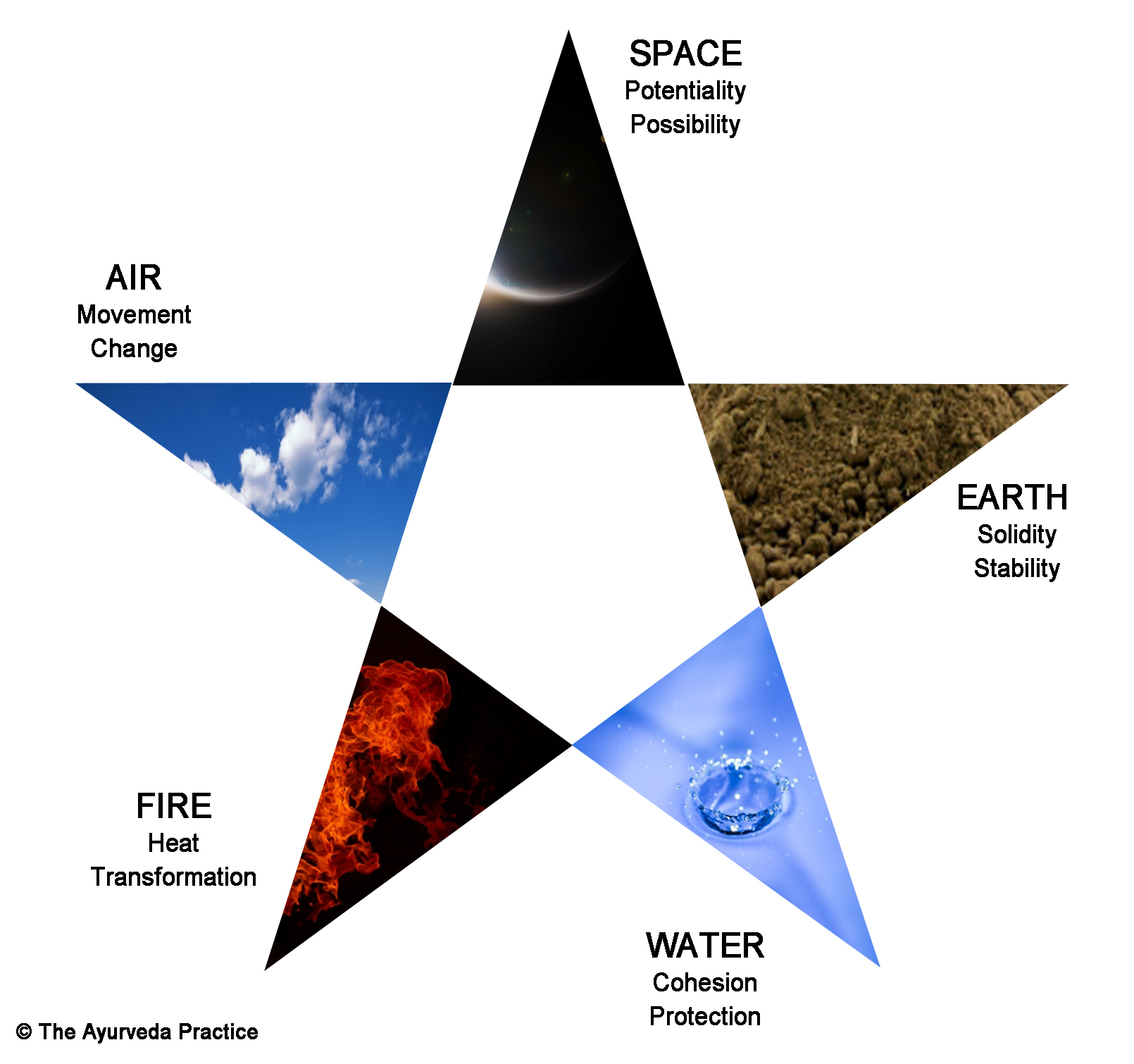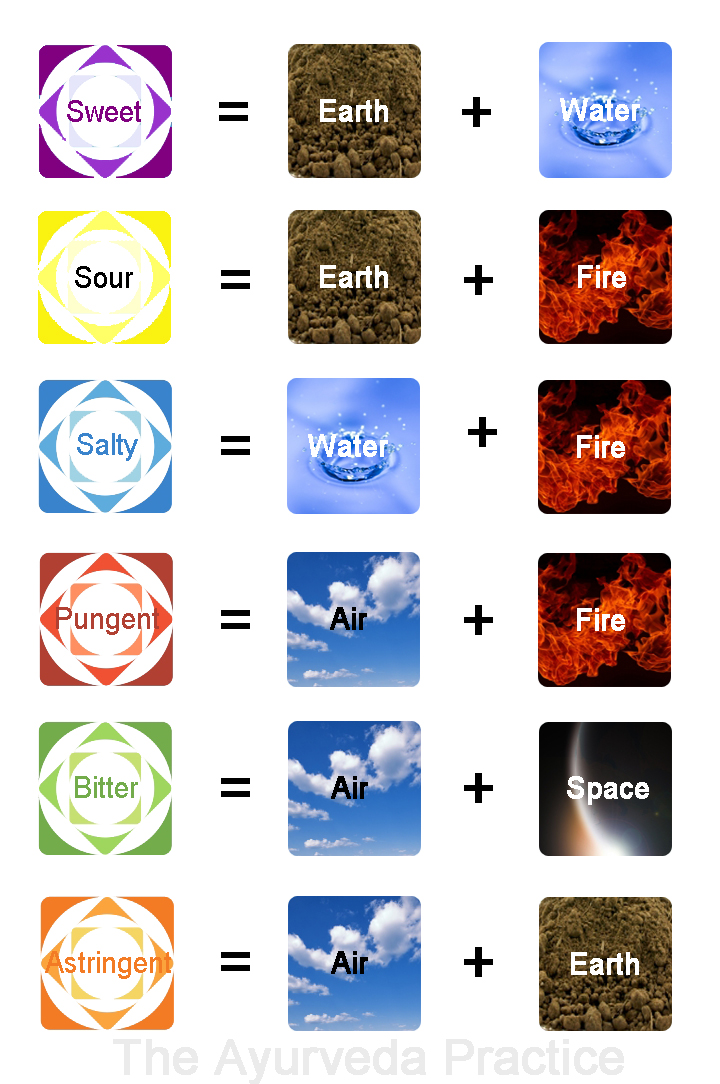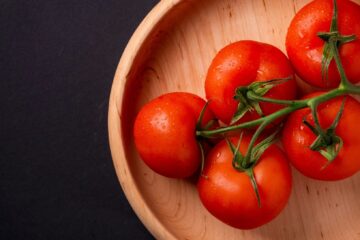Balanced meals, balanced person, that’s the concept. Ayurveda has a delightfully simple way of devising a balanced meal; it’s all done through taste. There are 6 tastes, and if you have a balance of all 6 in your meal, your meal will be nutritious and, importantly, satisfying (assuming that your ingredients are natural and unprocessed).
All substances in creation are formed of five fundamental elements; space, air, fire, water and earth.
 These elements are all present in differing quantities in various substances. The predominance of a particular element in a food dictates its taste. There are 6 tastes; sweet, sour, salty, pungent (spicy), bitter and astringent.
These elements are all present in differing quantities in various substances. The predominance of a particular element in a food dictates its taste. There are 6 tastes; sweet, sour, salty, pungent (spicy), bitter and astringent.
Sweet = Earth and Water, Sour = Earth and Fire*, Salty = Water and Fire*, Pungent = Air and Fire, Bitter = Air and Space, Astringent = Air and Earth. *Caraka
We, as human beings, are also formed of the 5 principle elements and we need to maintain our bodies and minds in equilibrium. It is thus easy to see why we need the correct balance of each of these tastes to keep us healthy. If we eat primarily with only a few of the tastes, this carefully maintained balance within our set-up will be lost and we will become unwell.
In our modern western diets, we often eat meals with just 3 main tastes (the most immediately gratifying ones) and therefore we are less easily satisfied, have a desire for more… and thus, overeating begins! If you think about a plate of chips (or fries for the American reader), you have sweet taste (peeled potatoes), salt taste (added salt) and sour taste (ketchup). It is these three tastes which dominate many of our meals and snacks and leave us unsatisfied.
Let’s have a look at each of these tastes.
Sweet
 We can tell the sweet taste as it gives pleasure and coats the mouth. It imbues strength and nourishment to the tissues.
We can tell the sweet taste as it gives pleasure and coats the mouth. It imbues strength and nourishment to the tissues.
This is one we know well in our diets. We will often think of sugar when we think of sweet but actually this is an unusual intensity of the sweet taste which we rarely come across in nature. The sweet taste comes from the carbohydrate, protein and fat in the food. In excess, this taste can block the channels in the body and slow us down.
Some natural foods we get the sweet taste from are:
- grains including wheat, rice, oats, corn. Anything made from these grains such as bread and pasta too.
- dairy products, especially milk
- meat (including chicken and fish)
- starchy vegetables such as potatoes, sweet potatoes, parsnips, squash
- ripe fruit
- sweeteners such as honey, syrups, molasses
We don’t usually find it hard to include this taste in our meals.
Sour
 The distinguishing signs of the sour taste are the increased salivation and contraction of the eyebrows – you know, that face you make when you suck a lemon. The sour taste stimulates appetite and strengthens digestive fire. It is also said to give us energy. The sour taste comes from organic acids in the foods. In excess, this taste can burn.
The distinguishing signs of the sour taste are the increased salivation and contraction of the eyebrows – you know, that face you make when you suck a lemon. The sour taste stimulates appetite and strengthens digestive fire. It is also said to give us energy. The sour taste comes from organic acids in the foods. In excess, this taste can burn.
Some people get confused between sour and bitter but they are fundamentally different tastes.
Sour tasting foods are:
- citrus
- berries
- tamarind
- tomatoes
- vinegar (and things pickled in vinegar)
- alcohol
Salty
 This taste enhances the taste in food. It opens channels, liquefies blockages in the body and helps stimulate appetite and digestion. The taste comes from mineral salts in the food. Excessive intake weakens us, especially in the reproductive systems and eyes, increases blood pressure and swelling. It can also lead to premature hair loss and greying and of course, it can make us thirsty!
This taste enhances the taste in food. It opens channels, liquefies blockages in the body and helps stimulate appetite and digestion. The taste comes from mineral salts in the food. Excessive intake weakens us, especially in the reproductive systems and eyes, increases blood pressure and swelling. It can also lead to premature hair loss and greying and of course, it can make us thirsty!
Foods with salty tastes include:
- salt (and anything to which salt has been added, including soy sauce or tamari)
- meat (including, quite obviously, fish)
- eggs
- dairy (especially cheese)
It is rare not to have enough of the salty taste in our food, especially if we eat anything processed as almost every processed food will have added salt.
Up to now, most of us will easily recognise and have lots of experience with these tastes in our diets.
Pungent
 Pungent (or spicy) taste is one that causes mild heating sensation on the tongue, throat and chest, is immediately stimulating and if strong, can cause tears, increased heart rate and sweating. The taste comes from essential oils in the foods. Pungent tasting foods stimulate digestion and metabolism and help clear passages (such as sinuses). In excess, they can cause burning and upset pitta and vata.
Pungent (or spicy) taste is one that causes mild heating sensation on the tongue, throat and chest, is immediately stimulating and if strong, can cause tears, increased heart rate and sweating. The taste comes from essential oils in the foods. Pungent tasting foods stimulate digestion and metabolism and help clear passages (such as sinuses). In excess, they can cause burning and upset pitta and vata.
It doesn’t, as commonly perceived, have to mean chillies; there are lots of milder pungent tastes.
- chillies, cayenne – these go beyond pungent to be aggravating to the body so are best avoided
- onions, garlic, leeks
- black pepper
- ginger
- mustard
- horseradish, wasabi
- nearly all culinary herbs and spices, especially allspice, anise, cloves, cinnamon, cumin, coriander, marjoram and paprika.
This is a taste we sometimes forget about but there is nothing better than this to help you digest your food so make sure to cook with herbs and spices or other pungent tasting foods.
Bitter
 This is more obviously perceived as an effect rather than an obvious taste. It leaves the palate clean and thus stimulates the other tastes. It is not a taste of which people naturally want to eat a lot. Foods containing this taste have detoxification properties and stimulate the digestive power. They are good for ridding us of toxins and fevers and they open up the channels in the body. The bitter taste comes from alkaloids or glycosides in the food. Eaten in excess (rare as it isn’t a naturally morish taste), excess gas may accumulate in the digestive system.
This is more obviously perceived as an effect rather than an obvious taste. It leaves the palate clean and thus stimulates the other tastes. It is not a taste of which people naturally want to eat a lot. Foods containing this taste have detoxification properties and stimulate the digestive power. They are good for ridding us of toxins and fevers and they open up the channels in the body. The bitter taste comes from alkaloids or glycosides in the food. Eaten in excess (rare as it isn’t a naturally morish taste), excess gas may accumulate in the digestive system.
Bitter tasting foods are:
- coffee (given as a perfect example of a strong bitter taste, not as a suggestion to drink any!) and green tea
- products of cacao/cocoa bean (most obviously tasted in dark chocolate)
- dark green vegetables and leaves (including spinach, salad leaves, greens, broccoli, kale, green cabbage, sprouts, parsley)
- green pumpkin seeds
- some herbs and spices such as turmeric and fenugreek
Most of us are guilty of not eating enough green vegetables, so try and find some imaginative ways to include them in your meal. I’ll often just throw a selection in the steamer as an accompaniment to most meals.
Astringent
 The taste that time forgot… This is a tricky one, but essential none-the-less. While bitter cleans the mouth, astringent dries it. It creates a drying, puckering sensation in the mouth (such as with cranberries) or a dry, chalky feeling (such as with many beans). It aids in healing ulcers and promotes clotting, preventing bleeding. It tightens tissues and absorbs fats (what’s not to like?). The taste originates from tannins in the food. We don’t need a lot of this taste but without it we won’t find satisfaction. If we eat too much of it (very unlikely!), it can cause constipation and obstruction of the channels in the body.
The taste that time forgot… This is a tricky one, but essential none-the-less. While bitter cleans the mouth, astringent dries it. It creates a drying, puckering sensation in the mouth (such as with cranberries) or a dry, chalky feeling (such as with many beans). It aids in healing ulcers and promotes clotting, preventing bleeding. It tightens tissues and absorbs fats (what’s not to like?). The taste originates from tannins in the food. We don’t need a lot of this taste but without it we won’t find satisfaction. If we eat too much of it (very unlikely!), it can cause constipation and obstruction of the channels in the body.
The most-asked question to do with this topic … what has astringent tastes?
- pulses such as lentils, dried beans (such as mung, kidney, haricot, pinto, aduki, black-eyed, soy) and chickpeas
- fresh beans (e.g. green beans) and peas
- other vegetables including cauliflower, broccoli, artichoke, asparagus, white potatoes (skins), sprouts (i.e. sprouted beans) and turnip (these are less astringent than the above)
- quinoa
- green apples, unripe bananas, pomegranates, persimmons, cranberries, pears, grape skins (and wine… also not recommended)
- herbs and spices such as oregano, turmeric, coriander, bay leaf, basil, rosemary and nutmeg
- black, white and green tea and rooibos (which can explain why often if we don’t feel satisfied after a meal, a cup of tea will ensure that we do)
Only a small amount of this taste is necessary. Include some fresh beans or peas in your vegetable selection. Adding lentils to a variety of dishes such as soups, stews and sauces can be easy as can including beans in a meal.
Eat your meals like this and feel satisfied and nourished.
Till next time, take care of yourselves.
Kate
Author: Kate Siraj, Ayurvedic Practitioner, BSc Ayurveda, MChem (Oxon), MAPA.
© The Ayurveda Practice
Elements photos thanks to FreeDigitalPhotos.net




7 Comments
Basharat Arshad · June 19, 2014 at 15:19
Kate…have read your article very carefully.
Interesting.
So now looking forward to recipes with all these elements present.
Although, I may think that we eat balanced or healthy food…but there is always room for new and healthy recipes.
Than kyou for all your information
Vibrant Ayurveda · November 30, 2015 at 04:02
I really like and appreciate your blog post. Much obliged.
Great, thanks for sharing this article.Much thanks again.
Good sleep, great health - · October 16, 2015 at 19:08
[…] well nourished and grounded by your diet (with naturally sweet, sour and salty tastes). Vata pacifying, sleep promoting foods such as these will be helpful: ghee, milk, grains, meat […]
Banish sugar cravings - The Ayurveda Practice · March 17, 2017 at 14:05
[…] view of sweetness, however, is different. The natural sweet taste is an essential and life promoting taste which we all need in our diets. The sweet taste is […]
Add spices, add flavour, improve nutrition - The Ayurveda Practice · October 13, 2017 at 12:06
[…] and spices, through their pungent and bitter tastes, kindle the digestive fire. This means our digestive power increases which shows as a keener […]
Enjoy your Christmas roast with impunity this winter - The Ayurveda Practice · February 26, 2019 at 08:20
[…] sour and salty: The tastes which nature provides in winter, and which we need, are predominantly sweet and salty. We also […]
Tomatoes: Ayurveda hates them… or does it? - The Ayurveda Practice · May 5, 2024 at 09:15
[…] sour taste stimulates appetite and digestive fire, moistens, satiates, encourages elimination and is good for […]